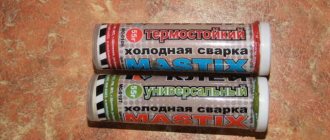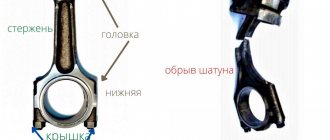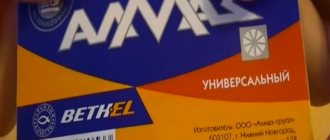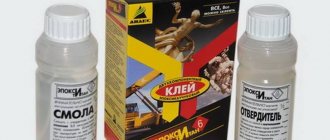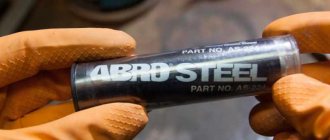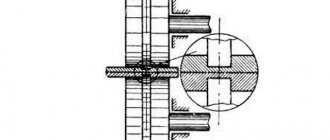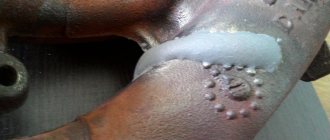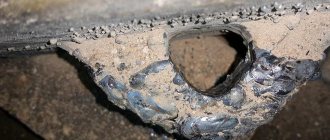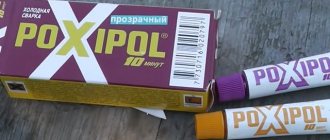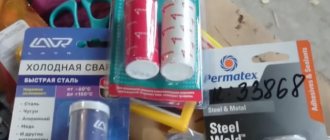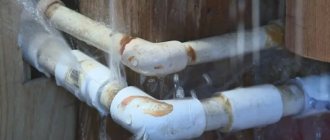Cold welding for metal is a special plastic composition for joining metal products without conventional (hot) welding, which is not always applicable.
The gluing process occurs due to the interpenetration of the mass of the composition and the bonded surfaces. Cold welding is easy to use and does not require special tools or any equipment.
This type of bonding in its action is pressure welding, and a continuous welding seam occurs during penetrating plastic deformation, which initiates the destruction of the oxide film on the joined planes and brings the distance between them closer to the size of the crystal lattice. The concentration of the energetic interaction of atoms on the planes being welded contributes to the establishment of chemical bonds .
Cold welding for metal - instructions allow you to glue products from any metals : silver and copper, iron and lead, zinc and aluminum. This method is a good solution for repairing metal parts that are sensitive to temperature treatment. With its help, you can weld dissimilar metals: surround aluminum wires with copper bushings.
Advantages of cold welding:
- since there is no heating, there is no disturbance in the structure of the metal, there is no deformation;
- it is possible to create a neat and durable seam;
- in many situations, only this method can be used - in emergency explosion- and fire-hazardous rooms, connect parts made of copper and aluminum;
- the method is environmentally friendly; when performing this welding, slag and other waste are not generated;
- To perform the work there is no need for special training, no special tools and equipment are required, and therefore no energy consumption is required.
What is cold welding
Cold welding is usually understood as a special adhesive that includes additional additives to create strong connections similar to welding. The most common cold welding is one or two component.
Cold welding can be liquid (liquid composition in tubes) and solid (or dry), usually cylindrical in shape, something similar to plasticine. Cold welding is used both in everyday life and in industry. The range of materials that can be joined is very wide. It is used for joining: metal, ceramics, glass, plastic and polymer materials, wood, plywood and many others.
How to fix a leak in your home heating system
If the leak is strong and a simple clamp cannot be used to close it, the heating circuit with liquid will have to be turned off. It doesn’t matter where the leak is found - on a heating or water supply pipe - eliminating the leak will only be possible by turning off the water supply. A disconnected circuit gives scope for repairs: you can at the same time check the entire route and repair (replace) all suspicious areas.
Let's start with the simplest ways to fix a leak in a heating pipe:
Seal the gap or hole with a fabric (fiberglass) patch liberally coated with epoxy glue. The patches (there should be 2-3 of them) are cut twice as wide as the diameter of the pipe; the length should allow the pipe to be wrapped 5-7 times. The metal around the violation is cleaned with sandpaper, a file or a grinder, the area is well dried, and epoxy resin is applied to it. The fabric can be soaked with glue in advance, or you can coat it as you wind it onto the pipe - whichever is more convenient on the spot. The last fabric layer is not saturated with glue, and the end of the fabric is secured with cord or wire. Epoxy dries on a pipe in different ways: at a temperature of 20 0 C-25 0 C, a few hours are enough; at a temperature below 18 0 C, even a day is not enough.
If you have repaired a central heating pipe, then the system operates under higher pressure than individual heating, and when water is initially supplied to the circuit after the repair, a noticeable water hammer may occur, which can simply rip off the patch. Therefore, the supply valve should be opened slowly, tracking the area with the patch visually.
You can increase the strength of the patch by adding bronze or aluminum powder to the epoxy glue. If you were unable to buy powder, you can make it at home by grinding off the surface of any non-ferrous metal part with a small file or needle file. By adding such powder, you can make not 5-7 turns of fabric, but 2-3, and repairing such an area will become easier and faster.
Factory materials
From ready-made solutions, adhesives and liquids, you can use a heat-resistant, waterproof sealant to seal the leak. Such adhesive compositions are produced specifically for the repair of heating systems. When purchasing, make sure that the word “neutral” is on the label - this means that your glue will not corrode non-ferrous metal and adjacent materials.
Cold welding is also good for eliminating leaks:
- A liquid epoxy substance that is convenient for impregnating fabric patches that are applied to a hole in a water pipe. Some compounds can also work on a wet surface;
- Semi-solid plastic compositions. This cold welding looks like a small piece of plasticine consisting of two different component strips. Knead the plasticine in your hands until the substance becomes plastic (your palms should be wet - moisten them in water), cover the hole in the pipe with a small piece, and spread it over the cleaned surface. It takes 10-15 minutes to harden, after which the patch becomes so hard that it is difficult to take even with a file.
Both liquid and solid cold welding contain toxins, so it is recommended to use rubber gloves when working with it.
Sealing connections on pipes and between radiator sections
If connections at the junction of pipes or fittings are leaking, then, depending on the difference in diameters, you can immediately seal the pipeline with a metal clamp or first wrap rubber in place with a smaller diameter. The rubber band is easily wound even under pressure, stopping severe leakage.
BF-2 glue works well for sealing the threaded connection in the place where tow or FUM tape is wound. The tow is first soaked in alcohol, then coated with glue. The glue dissolved in alcohol impregnates the winding, and after drying it forms a dense waterproof layer.
What else can the winding be impregnated with and what can you wrap the pipe with so that it does not leak: in most cases, ordinary oil-based (not nitro) paint is used. To do this, wrap the tow around the thread, apply the paint with a brush, and after tightening the thread, paint this area 2-3 more times. You can turn on the heating or water supply only after 2-3 days.
If you can’t fix the leak with your own hands, you need to turn off the heating or water supply and redo the threaded connection: completely remove the old winding, clean the threads and degrease them. New tow or FUM tape must be wrapped with preliminary impregnation with sealant or paint.
- When a metal-plastic fitting leaks, it is easier to eliminate a water supply network leak: you can stop the leak by simply tightening the thread. In 90% of cases this helps;
- To stop the leak, the copper circuit only needs to be soldered;
- Propylene pipes on the heating circuit are repaired by replacing the cracked section with a new section of pipe - this requires a special welding machine for welding PP products - there are no other ways to weld propylene.
If you don’t know what to do if there is a leak between battery sections, then the most common repair is replacing the gasket between the radiator elements, or replacing the nipple. To do this, the system is turned off and the failed part is replaced with a new one. There are no other options other than temporary repairs - applying a patch using the method described above. This is a rather complicated process, since aluminum radiators have a very small distance from section to section.
To seal a leak on an aluminum surface between sections, you need to somehow manage to clean hard-to-reach places. To do this, you can use a cable - you need to wrap it around the leak and pull the ends one by one until all the paint is erased. A clean aluminum surface is sealed with epoxy mixed with aluminum powder or by cold welding.
Few people know, but you can coat a heating pipe with regular table salt! A small hole in a water supply line or heating pipe will immediately stop flowing if you rub it with a pinch of salt. If the hole is rather large, then salt is used together with a regular bandage - rewinding the leak area, sprinkle the bandage with salt.
If an aluminum radiator is leaking, then repair is a temporary measure for one season. To get through next winter, the radiator needs to be changed - it will definitely leak in another place.
How to fix a leak on a radiator
Not between sections, not on the threads, but simply on the body of the radiator - such cases occur mainly with cast iron or steel devices due to cavities that occur in the casting. Temporary repairs can be carried out as follows:
- The easiest and fastest way to stop a leak if the hole is small is to hammer a wooden plug (plug) into it. Level it with the surface of the product, cover it with sealant or cold weld;
- In addition to wood, a self-tapping screw or press washer will work well. The hardware also needs to be lubricated with sealant before screwing it into the hole.
Leaking hidden pipes
It is clear that this is the biggest nuisance that can be imagined in a newly renovated apartment. There are two options for how to seal to prevent pipes from leaking in the wall or under the floor:
- If this is a heating route, then add 100 grams of dry mustard to the expansion tank. 2-3 hours are enough for small holes to heal. The next day, you need to drain the mustard water from the system and fill in with new, clean coolant. This is done to prevent the filters in the heating circuit from becoming clogged;
- Mustard is a popular household method, but factory sealants that need to be poured into the coolant to prevent the pipe from leaking also work. The principle is the same - the next day the liquid is drained and replaced with clean one.
Features of application
The main features characterizing cold welding are:
- ease of use;
- no special skills required;
- the repair will take a few minutes;
- low cost
Also, one of the features is that to use cold welding you do not need to use complex or expensive tools (welding equipment). This is very good in cases where there is neither electricity nor gas for ordinary welding.
Benefits of Mastix
- Mastix cold welding adhesive is a universal product that helps to glue almost any surface much better than other types of adhesives;
- Several varieties are produced that have improved properties, for example, cold welding for metal, plastic, aluminum, although there are also universal brands;
- The mixture is easy to use and prepare, so its use does not require extensive experience or special knowledge;
- Relatively inexpensive products and available in many retail outlets;
- Convenient delivery option in the form of a two-component rod;
- Wide operating temperature range.
Compound
The composition of cold welding is most often based on epoxy resins, as well as additional additives that give the joint certain properties. Some compositions add reinforcing substances in the form of metallic inclusions (metal powder, polymer fibers, etc.) which increase the strength of the joint. If we are talking about hard cold welding, stabilizing (thickening) components are added to the composition.
For compositions that operate at high temperatures, heat-resistant filler components are added to prevent the destruction of the “welded” area.
How to fix a leak in a pressurized water pipe
- If a pipe is leaking when the coolant pressure is low, then an ordinary iron pipe clamp to eliminate the leak is a sure and quick solution to eliminating a leak in the heating system. The factory clamp is a round metal structure with a wall thickness of 1-1.5 mm, rubberized on the inside and equipped with a bolt and a nut for tightening (or a pair - depending on the width of the clamp);
- People's advice on how to seal a leak if there is no steel clamp: wrap the accident site with rubber from a bicycle tube, a pharmaceutical bandage, or any suitable piece of rubber, for example, a rubber glove. You can secure such a homemade clamp with wire, or wrap it with any cord;
- In the absence of a factory clamp and rubber, you can make a homemade clamp from tin, even from a tin can lid;
- Even a piece of elastic polymer (for example, vulcan rubber), tightly wrapped with wire, turn to turn, can temporarily save the situation.
Other methods of eliminating an accident if a heating pipe is leaking will not work - only dry surfaces can be sealed with cold welding, although the hardened composite can then work even in water. It will not work to seal a hole or crack with sealing compounds for the same reason - the surface to be repaired must be dry, and preferably clean. Therefore, sealant for heating pipes, epoxy resin, dichloroethane and other fast-hardening composites are used only on disconnected dry sections of the heating route. This also applies to the repair of the water supply line in the water supply pipe for hot water supply or hot water supply.
What is cold welding?
Now let’s take a closer look at what cold welding is available for sale and how it differs from each other.
Dry
By dry, as mentioned earlier, we mean solid, two-component cold welding, which consists of cylindrical bars packed in plastic flasks or plastic bags. It is this type of cold welding that is most often used, as it is very common and universal in application. They can be used to glue most hard materials. There is no need to measure and dose as all components are already prepared in the required proportions. You just need to cut off the required amount of the composition.
To use it, the composition is kneaded by hand to the consistency of plasticine and applied to the “welded” surfaces. Below you will find detailed instructions with recommendations.
Liquid cold welding
Liquid cold welding can be either one- or two-component. It is usually packaged in a tube of various sizes. Sometimes there are packaging options for a mounting gun. Naturally, liquid cold welding does not need to be kneaded by hand.
In cases where the composition is one-component, it is simply applied to the prepared surface. If the composition is two-component, it is pre-mixed in the proportions specified by the manufacturer. You can experiment with the selection of proportions yourself; for example, to speed up the hardening process, you can increase the amount of hardener. But it’s still better to mix according to the instructions because you can spend quite a lot of composition on experiments.
Liquid welding can be aerobic or anaerobic (which dries without oxygen). Anaerobic products are highly specialized and used in industry. Probably the most common liquid cold welding agent is Poxypol glue. You can read more about it in the article by following the link.
Cold welding, both liquid and solid, can be universal and specialized.
Universal, suitable for most materials, provides average joint strength. Special, focused on gluing certain materials. They, in turn, provide higher quality connections. Metal powder is added to compositions for gluing metal; for gluing concrete or ceramic surfaces, a filler containing polymer and ceramic inclusions is added.
This is especially clearly seen in cold welding for linoleum, which ensures the connection of linoleum without noticeable seams. Of course, this cannot be achieved using universal cold welding.
Specialized types of cold welding are focused not only on the material that needs to be “welded”, but also on the conditions in which the product operates. There are such types as:
- temperature resistant;
- oil- and gasoline-resistant (most often used for automotive repairs);
- cold-resistant;
- moisture resistant.
Car cooling system radiator repair.
A car cooler is a heat exchange device that is very sensitive to mechanical influences. It happens that when driving at high speed, a pebble or other hard object stuck in its mesh will lead to the formation of a leak. And this already requires urgent repairs. By cold welding it is quite possible to eliminate the leak and at least temporarily restore the functionality of the cooler itself.
The recommended operating procedure is as follows:
The first thing to do is to choose (buy and have in the glove compartment of the car a type of “cold welding” suitable for such repairs. It must have good adhesion to the metal and withstand high temperatures. The best option would be to purchase a special composition specifically designed for repairing heating radiators, but if they are not available for sale, you should choose a heat-resistant option for metal. If “cold welding” does not have these properties, then when heated, the repair pad will simply melt or come off, that is, all the work done will be in vain.
The next step is to determine the exact location of the leak. It is possible that for this you will have to dismantle the radiator. It should be noted that this stage sometimes becomes the most difficult in the entire radiator repair process.
Liquid - antifreeze or water - has been drained from the vehicle's cooling system. If the search for a hole or crack is preceded by disassembling the radiator, then, of course, the coolant is drained before disassembling. Removing a clogged part of the radiator grille
You may need to remove part of the radiator grille to locate the hole in the pipe and also repair it.
It is recommended to dry the radiator, for example, with a stream of warm air. But if you purchase cold welding, which can be applied to a wet surface, then drying the entire structure is not necessary, although it is still desirable.
Having found a hole in order to free up space around it, it is recommended to sand the surface on which the “cold welding” will be applied, then clean it of any abrasive residue and degrease it with white spirit, acetone or gasoline. This procedure is necessary to obtain high adhesion of the repair mixture to the metal. Then you can move on to working with glue.
You need to act according to the instructions usually found on the cold seal packaging. The process of preparing a rigid two-component “cold welding” version for work.
Before starting work, it is recommended to wet your hands with water - this will help the glue stick to them less.
The required amount of mass is cut out from the glue stick with a knife. The cut fragment is vigorously kneaded with your fingers until elasticity and complete homogeneity are achieved. Since the cold-welded components vary in color, care must be taken to ensure that the shade of the mixed mass is also perfectly uniform. Plasticity, homogeneity and clearly visible heating of the mixed mass are a sign that the glue is ready for the next operation.
If a two-component liquid “cold welding” option is chosen for repairs, then it is necessary to take a certain amount of the composition from the tubes and mix well in a small container or even on some surfaces. The ingredients are not yet so liquid that they start to run off.
The next step is to apply glue to the damaged area. All stages of work should be carried out without wasting time, since after mixing, some adhesives quickly begin to enter the polymerization stage. The setting time of the material must be found out in advance from its passport characteristics.
Complete drying and readiness of the repaired product for use can occur in a period from an hour to a day. The time to achieve such readiness may depend on several factors - the temperature at which the work was carried out, the thickness of the applied layer, as well as the characteristics of the “cold welding” itself.
It should be noted that, according to reviews from car owners, sometimes such repairs of cooling system radiators turn out to be more effective than argon welding or “classic” soldering.
A damaged fuel tank is repaired in the same way. It’s even simpler here, because most often you need to process an open surface, without a metal mesh. True, precautions when working with the tank are much stricter due to its increased flammability. After drying, the adhesive “patch” can be further treated with abrasives and then coated with the same anti-corrosion paint that was used to cover the rest of the surface of the tank.
Where is it used?
The scope of cold welding is very wide, so we will step by step analyze the main areas of its use.
Plastic
Application of cold welding for plastic. Mainly used for repairing plumbing leaks and polymer pipes with low pressure up to 30 bar. In principle, this is more than enough for household needs when repairing leaks.
It is also possible to restore the holes in which the screws were screwed, but were damaged and the screw began to slip. In these cases, the holes can be filled with cold welding, and after drying, the screw can be screwed in.
Also perfect for repairing children's toys, cars whose wheels have come off, or dolls. There is one truth here, but it is only suitable for toys of children who are over 3 years old and who will not put them in their mouths because the ingredients are toxic.
Metal
Connecting metal parts using cold welding is much inferior in strength to conventional welding and even soldering, but nevertheless it is often useful for metals.
An important condition here is that the connection is not subjected to impact and bending loads.
Cold welding, just like for plastic, will maintain water or air pressure. Therefore, it can be used when repairing plumbing equipment, for example, when repairing a faucet in which a small crack has formed. You can also repair the threads or body of the ball valve (as a temporary solution).
Useful article - Silumin what kind of material is it
Wood, plywood, fiberboard
Cold welding glues wood and wooden products together with a bang. The strength of the connection is commensurate with the strength of the parts themselves. It is mainly used for furniture repair. It can also be used to restore chipped surfaces by simply filling them with cold welding, after which it is sanded and painted.
Car repair
When repairing a car, cold welding is very helpful. It is used when repairing bumpers by gluing fragments on the back side. It is used to repair leaks in the cooling system, in particular radiator tubes. Sometimes used to repair plastic elements of a car’s interior such as mirror housings, DVRs and many others.
Characteristics and description of the range of reaction adhesives
The cold welding method will serve as an effective replacement for electric welding in repairing products with minimal damage.
It will also help eliminate leaks in large items that may be difficult to access using hot welding.
It is worth mentioning the economic component - repairs using cold welding will cost less.
A wide variety of adhesives are currently produced
- automotive - can be used to repair pipes if the instructions indicate resistance to high temperatures
- intended for plastic - usually these are products that can withstand heating up to +260 degrees, therefore, their use for repair work is acceptable
- universal - designed to work with most materials, including stone, wood, glass, concrete, plastic and metal
- super waterproof products can also be used
Do not try to fix leaks with products designed for plumbing or wood. They do not have sufficient heat resistance and adhesion and will not be able to create a reliable, strong joint.
High-quality formulations are produced by both foreign and domestic manufacturers.
The latter have a more favorable price. However, you should not buy very cheap adhesives; their quality leaves much to be desired.
At what temperature can it work?
The temperature at which you can work with cold welding differs from manufacturer to manufacturer, and also, of course, from the type of cold welding itself (liquid or dry). But the general rule here is to apply cold welding at a temperature no lower than + 3... +5 degrees Celsius and no higher than 35...40 degrees. Maintaining this temperature range is important because adhesion and hardening speed depend on it. The most optimal temperature for working with cold welding is +20 ... +24 degrees. At this temperature, good adhesion will be ensured and at the same time the composition will not harden too quickly.
When cold welding has already hardened, it can work in a temperature range from -50...-45 degrees Celsius to +120... +130 degrees.
Heat-resistant cold welding can withstand temperatures up to 900...1200 degrees. It can repair car muffler pipes, as well as stove elements.
Temperature characteristics
The gluing process occurs without heating with plastic deformation. This is good and bad at the same time. Otherwise, without establishing deep interatomic bonds in the parts being connected, but strong enough in normal practice for quickly and efficiently connecting parts, sealing cracks, eliminating leaks, and filling the surface.
Manufacturers' instructions are almost the same when it comes to preparing and using the working composition. Definitely at room temperature 18-20°C, with a deviation of 10 degrees in one direction or another, without changing the initial and, especially, final properties.
Working operating area from -60 to +260°С. High temperature cold welding reaches a maximum of 1316 degrees Celsius.
What cannot be repaired
The first thing I want to say is, of course, that you cannot use it when repairing dishes or any other items that come into contact with food. The composition of cold welding includes toxic elements that can be dangerous if ingested. For the same reason, you should not repair children's toys for infants, who may subsequently put them in their mouths.
Do not repair drinking water pipelines (can be used as a short-term solution as a last resort)
You should not use heating when repairing pipelines, because the temperature in them changes, and accordingly the metal from which they are made either contracts when cooled or expands when heated. The compositions from which cold welding is made have a different coefficient of linear expansion, which will lead to cracking and leaks. Can be used to eliminate leaks, but only for a short time.
Do not use when repairing gas pipes and gas equipment in general. There is a high risk of gas leakage, which in turn can lead to a fire or explosion.
TYPE A WELDING TECHNOLOGY.
Linoleum is laid sequentially, canvas by canvas, overlapping by 50-60 mm. For an even junction of the canvases, at the seam, both canvases are cut through with a special knife along a ruler, in the middle, the knife must be held at right angles to the floor. Double-sided construction tape is glued to the floor under the seam in order to fix the linoleum to the floor. Sequentially glue to the tape, first one sheet of linoleum, then carefully the second. One-sided tape is glued to the top of the front side; you can use masking tape. This allows you to work with welding more efficiently, protecting the edges of the linoleum being welded from the damaging effects of welding (adhesive solution). Then cut the tape along the seam with a rounded knife. Carefully pour glue directly into the seam, which is easily squeezed out of a tube with a special spout. By pressing the nose directly into the seam, so that it gets into the seam and spreads over the surface of the protective tape by about 5 - 6 mm.If glue gets on the coating, drops of it should not be removed immediately. After hardening, they should be carefully removed with a knife. Wiping off uncured glue can damage the coating pattern. The quality of gluing can be improved by rolling the seam with something heavy.
The glue dries completely in about 2-3 hours. After which you can remove the protective tape by carefully pulling it at an acute angle to the floor.Advantages and disadvantages
Now let's talk a little about the main advantages and inevitable disadvantages of cold welding.
The main advantages are:
- the ability to connect dissimilar materials (plastic + metal; metal + ceramics, etc.) that cannot be connected using conventional welding methods;
- no skills are needed for application, just follow the technology;
- no specialized expensive equipment required;
- you can repair structures without dismantling them (for example, draining water from a leaking tank);
- mobility - can be used anywhere since neither electricity nor gas is needed;
- when connecting, the product does not heat up and therefore does not deform;
- has a wide distribution (sold in a large number of specialized stores and supermarkets);
- The method is productive (the connection process does not require much time)
- corrosion resistance – the “welding seam” does not rust.
Now let's talk about the disadvantages that also exist, here are the main ones:
- the strength of the connection is significantly inferior to welding;
- strength indicators largely depend on the quality of surface preparation (the strength of the connection can vary greatly);
- not applicable for dishes and other items that come into contact with food;
- not applicable for critical connections.
If, after all, cold welding does not help you and you need to get a stronger connection, then read our article on how to weld by clicking on the link.
Classic high temperature welding
How to weld heating from an iron pipe in accordance with building codes is indicated in GOST. Both the diameter of the pipes and the length of the system matter. SNIP will indicate how to properly weld heating pipes in each specific case: private household, multi-storey building or industrial water supply line.
When using a gas welding machine, creating high-quality seams will require considerable practical experience. Electric welding can also create welded joints of impeccable quality, but in this case you will need not only experience, but also high-quality electrodes, the correct current level and “arc feeling”. High-quality electric welding of heating pipes is available only to real professionals.
Metal pipes are the most common material for heating systems
The strength of metal pipes is more than sufficient for the water supply system and for the heating circuit. It is the connection sections that have to be implemented in order not to deviate from the design documentation that are the “weak link” of the system. How to weld a heating pipe using electric welding is described in detail in outdated training materials and articles. In modern construction, the cold welding method is more often used for heating pipes.
It is important to know! Threaded connections for metal pipes are used in cases where it is necessary to create a detachable connection. The tightness of the connection in this case is guaranteed by a sealant, most often tow.
Every qualified installation engineer knows how to weld a heating pipe correctly. There are a number of rules that must be followed:
- The weld should not consist of scale. This happens if you weld a pipe by electric welding using low-quality electrodes.
- To weld metal with an electric welding machine, it is necessary to use a multilayer metal melt method. Primary weld scale is removed before the next welding layer.
- It is important to choose the correct current level - low current does not guarantee the strength of the weld. Excessively high current during welding is also unacceptable.
- If the butt welding method is used, the electrode metal or molten wire is used as the reinforcing material.
- Electric welding of metal pipelines and other elements of heating and plumbing systems is prohibited near flammable objects.
Gas welding is a universal method for creating a strong connection between metals; metal parts of different sizes can be connected in any combination.
For traditional welding you need to have special equipment and welding experience
The high temperature of the burning gas stream allows you to melt the metal in the area of local heating, and cook the metal at the molecular level. Requires expensive equipment and highly qualified welders.
How to choose the right one
To choose the right cold welding, you need to pay attention to 3 important points:
- material of connected parts;
- the environment in which they will work (humidity, temperature, medium, pressure, etc.)
- The gap in the product (this will determine which cold welding you need to use, dry or liquid)
The first and most important is to select a cold weld for the type of materials that need to be joined. If you need to connect parts, for example, made of aluminum, then it is better to choose a specialized composition for aluminum, and not just a universal one.
Well, if you need to weld aluminum using ordinary welding, then read our article on how to weld aluminum by clicking on the link.
It is also very important to consider the environment in which the product will operate. For example, if we are repairing a cracked car muffler, we need to use temperature-resistant cold welding, and if we need to fix a leak, we need to choose a water-resistant compound.
As for the gaps in products, everything is quite simple; if we need to restore a broken piece from something that we don’t have (that is, the gaps are large), we need to choose dry cold welding and fill the resulting holes with it.
In cases where we need to repair a crack, it is actually better to glue the joint together using liquid welding because it provides a higher level of adhesion.
TYPE C WELDING TECHNOLOGY
First, the worn edges of the coating sheets to be glued are trimmed.Check the condition of the base under the seam area; it should be smooth and dry.
The linoleum joint must be cleaned of dust and dirt. Vacuum well. One-sided masking tape is glued to the seam and cut along the seam area. Raise one of the edges to be glued and squeeze the cold weld onto the cut of the other part so that this edge is generously covered with glue. Place the raised edge in place, pressing it tightly to the base. After 10-15 minutes, remove the single-sided tape. Cold welding that accidentally gets on the coating is not removed; it is necessary to wait until it dries completely and then remove it with a sharp knife.Instructions for use
There are a very large number of manufacturers and brands of cold welding, and therefore the methods of application vary. But for the most part, the application technology is the same. Let's consider it in more detail for each type.
Dry (solid form)
To use dry cold welding, you first need to thoroughly clean the surfaces to be joined from any types of contaminants (rust, oxide film, paint, etc.), and then you need to degrease the surfaces with acetone, a special degreaser, or a water-alcohol solution.
Afterwards, the surface must be dried, but it is better not to wipe the grease-free surface with rags, but rather let it dry. Because a rag can bring additional dirt to the surface.
Now you need to prepare the composition for use. To do this, measure out the required amount of the composition, cut it off, and then knead it in your hands.
Most manufacturers recommend performing this process with gloves so that the composition does not get on the skin of your hands. Depending on the amount of composition used, it is necessary to knead for 1 to 5 minutes until the composition becomes plastic and homogeneous.
Afterwards, you can apply the composition to the surfaces to be joined and fix them. Allow the necessary time for hardening.
During the drying process, the surface should not be loaded in any way. You also need to monitor the ambient temperature; it should not be below minus 5 degrees and above 30 - 35.
Liquid
Surface preparation for liquid cold welding is, in principle, no different from that used for dry welding. Surfaces are cleaned and degreased. If liquid welding is used for plastic, then in this case it is necessary to remove the top layer from the surface of the polymer. This can be done using a knife or cutter. This action will significantly increase adhesion, and therefore the connection will be much stronger.
If the composition is one-component, it is simply applied in a thin layer to the surface, after which the edges are fixed.
Just like with dry welding, it is necessary to maintain the drying time and not load the product being welded.
In cases where a two-component composition is used, it is mixed in the proportions specified by the manufacturer. After mixing, the composition is applied to one or both surfaces to be joined.
Technological process
The entire process of repairing radiators and heating pipes, regardless of what material they are made of, is carried out in two stages: preparatory and main.
Preparatory work
The content of the preparatory stage depends on what requirements the adhesive composition itself places on the product being repaired, including the requirement for the presence of pure metal on which the composition will be applied.
If the preparatory stage meets the requirements for providing the adhesive composition with access to pure metal, then it will consist of the following steps:
stripping the repaired area to bare metal. In the case of a thin layer of coating, for example, paint, you can get by with a metal brush. However, in the case of a thick layer of coating, mechanical cleaning may be required using a special circle and grinder
If an old pipe is to be repaired, stripping down to the metal should be done with extreme caution; after the metal has been cleaned, the surface should be degreased, for example, using alcohol or other liquids whose chemical composition allows the metal to be clean. If cold welding does not require mandatory cleaning of paint and varnish coatings, the cleaning step immediately begins by degreasing
The degreasing itself is carried out using a cotton swab or other material. In this case, it is desirable that such material be lint-free, since, otherwise, its microparticles can negatively affect the cleanliness of the coating.
Main stage
The next stage is the main one, during which the repair itself takes place using cold welding, consisting of the following steps:
- preparation of the adhesive composition. It is included in the main stage, since it requires very quick implementation of all necessary actions due to the fact that the composition itself hardens very quickly, which can lead to it losing its plastic properties even before application to the repaired area;
- if we are talking about a one-component composition, it is necessary to cut a piece of such a size that it is enough to cover the area that needs to be covered for the purpose of repair. This piece needs to be kneaded to such an extent as to obtain a plastic mass that will take the shape that is required in the area being repaired;
- if we are talking about a two-component composition, it is necessary to mix the elements of this composition in equal proportions in order to obtain a mass of the required quality, after which it will be ready for use as part of the repair being carried out;
- The next step is to apply the composition itself to the repaired area. As mentioned above, the application of cold welding must be carried out quickly, otherwise the polymerization process (that is, solidification) will occur much earlier, as a result of which a high-quality connection will not be obtained;
- After the composition is applied to the repaired area, this area must be protected from environmental influences. This can be done using a special clamp or clamp, which is put on for the period indicated on the package with cold welding (this is the period of maximum hardening of the composition, after which it acquires its maximum strength).
When working with cold welding, you should remember safety measures to protect the skin of your hands - all work must be done with gloves, and in order to prevent the composition from sticking to your hands, the surface must be moistened with water (for example, using cotton swabs).
Security measures
Cold welding is a fairly safe joining method, unlike classical welding, where metal melts under high temperatures. However, there are still dangers in use.
Mixing cold welding, both liquid and dry, and the application process must be performed with gloves (preferably rubber). This will protect the skin of your hands from burns from the components of the composition.
When applying liquid compositions, you need to be very careful so that the composition does not get into your eyes. In case of contact, rinse with plenty of water and immediately consult a doctor (ophthalmological emergency room).
When using a liquid composition for plastic and linoleum, care should be taken to ventilate the room since the composition uses solvents.
You should also be very careful to ensure that cold welding does not reach children. Dry compounds are similar to plasticine and they are often interested in them.
Flaws
- Welding for batteries is designed only for low loads, so it is not suitable for serious repairs and other methods must be used;
- The reliability of the seam largely depends on the technology of the process, since if all the rules have not been followed, the composition may not be applied properly;
- When applying welding, you need to adapt to the specified temperature conditions;
- The resulting seams cannot be considered very durable.
Varieties
Cold welding for steel heating pipes is a popular product that is manufactured by several companies. There are both domestic and foreign manufacturers on the market, differing in both price and quality. Recognized leaders in this area are HI-Gear and Abro. Among domestic manufacturers there are also several specialized brands that are marked “for pipes”. Polymet and Almaz are popular among manufacturers.
Cold welding HI-Gear and Abro
Compound
The material contains the following elements:
- Epoxy resin is the basis for glue, which gives the entire substance uniformity and plasticity;
- Additional components - to improve the bonding property, such as sulfur, etc.;
- The metal component is responsible for increasing the strength of the material in a frozen state and a longer service life.
Specifications
The characteristics of the material used are one of the main factors to pay attention to. This variety has the following characteristics:
| Characteristic | Meaning |
| Minimum temperature of use, degrees Celsius | -60 |
| Maximum temperature of use, degrees Celsius | -150 |
| Plasticity retention time, min | 5 |
| After how long can the load be applied, hours? | 2 |
| Package weight, g | 50 |
Choice
Cold welding for plastic and metal pipes can be very different. The difference lies in the strengthening element included in the composition. For metal products, it is advisable to select those options that match the filler material with the metal of the pipes. Accordingly, there is no need to choose too hard grades for plastic heating pipes. In any case, liquid grades are not suitable for the surface of the pipe.
Cold welding of heating pipes under pressure will be the strongest. The most resistant materials with high tensile strength are used for it.
Instructions for cold welding of heating pipes
The first step is to prepare the surface on which the composition will be applied. It should be cleared of dirt and dust particles to keep it as clean as possible. Then it needs to be dried. A dirty and wet surface adheres tens of times worse. After this, you can cut off the part of the glue rod to the size you need and knead it for 5 minutes until it becomes as elastic and soft as possible.
A sticky, homogeneous mass should be applied to the location of the crack, leak, or other problem that you are dealing with. The surface must be completely covered with the composition. To smooth out the glue, you need to use a spatula or other similar object.
Security measures
Cold welding for PVZH and other materials, as a rule, is not safe in contact with skin and mucous membranes. Direct contact should not be allowed. Work must be carried out wearing protective gloves. The cutting knife should not then be used for food products. In case of accidental contact with the mixture, rinse your hands or eyes in running cold water. If complications arise, it is better to consult a doctor.
Features of the use of cold welding
The main feature is the great attention to the preparatory stage. How well everything will turn out depends on the thoroughness of its implementation.
Even the service life of cold welding for heating pipes depends on how well the material adheres.
Typical mistakes at work
Let's look at the main mistakes that are most often made at work.
- Surfaces are not prepared.
- The connection is loaded until it dries.
In cases where the surface is not prepared, the level of adhesion is significantly reduced and the cold weld simply falls off.
When a joint is loaded before drying, microcracks appear in the structure, which greatly reduce its strength. If this happened at the stage of primary hardening, then displacement of the edges is possible.
Useful tips
Read the instructions! It is advisable to prepare the surfaces for applying glue as best as possible. Clean from rust, dirt and oil products. Sand to increase adhesion. Do all this in advance, since the survivability of the composition, as a rule, is no more than 10 minutes.
The required amount of plasticine should be cut with a knife, which is best moistened with water. Do not tear it off with your hands, otherwise the proportions of the glue will be disrupted. Knead with your hands, also moistened with water, until the mass is heated and smooth. A chemical reaction will occur. Then apply it tightly to the part being repaired and leave it alone until complete polymerization.
After the required time has elapsed, subject it to mechanical processing, other mechanical influences or painting. Or apply a second layer. As you can see, nothing complicated. Watch my video on how to use cold welding.
Common Applications
Due to its versatility, low cost and ease of use, cold welding has become very widespread. Here are the main areas where it is used:
- Electronics and electrical engineering;
- repair and restoration of plumbing;
- connecting linoleum joints;
- minor repairs of household appliances, case parts of laptops, computers, etc.
- car repair;
- restoration and repair of ceramic, stone and glass surfaces.
- fixing floor coverings during installation.
Plastic and PVC pipes
In most cases, plastic pipes have to be repaired when they leak. To do this, you need to use cold welding glue specifically for plastic. If there is water in the pipe being repaired, it must be drained and the damaged area dried.
Next, you need to clean the connection itself and a distance of 30–50 millimeters from it on both sides.
Now degrease the surfaces and let it dry.
We prepare the composition for use according to the manufacturer’s instructions; if there is none, use the one given in this article.
We apply the composition to the prepared surface, fix it and wait the necessary time for complete drying. In some cases, it is recommended to use fiberglass mesh reinforcement. The mesh is wound after each applied layer of cold welding. Performed in 2 – 3 layers.
The finished connection can be cleaned with sandpaper and painted.
Linoleum
The method of cold welding linoleum is quite simple and even a beginner can join the sheets the first time. No special skills are needed here, the only thing required is strict adherence to the instructions and accuracy.
There are 3 types of adhesives for linoleum: A, C and T.
Type A - used in cases where new linoleum is being laid and the gap between their sheets is minimal, no more than 0.8-1 millimeter. This type contains a large amount of solvent and is quite liquid. The tube has a needle at the end that is closed with a cap. The glue is fluid and easily penetrates the joint; if the edges are factory-made or very well prepared, the seam will be invisible. Glue vapors are toxic due to the large amount of solvent in its composition; this must be taken into account when working with it.
The next species is View C.
This type is most often used when repairing old linoleum, as well as during installation, in cases where the joints are poorly prepared and there is a large gap in them over 1.5 millimeters. The composition of the glue is thick, which allows it to fill large gaps well. Contains the same solvent as Type A plus PVC additives that form a new seam. This type takes longer to dry than type A, drying time is about 24 hours at a temperature of +18– + 22 degrees Celsius. The seam is strong and is not inferior to the strength of the linoleum itself.
And the last type is Type T.
Type T, like Type A, is based on the dissolution of the edges and therefore it is also necessary to properly prepare the edges with minimal gaps. A distinctive feature is that this type of glue is used for linoleum made on a textile basis (multilayer or duplicated linoleum) and instead of a needle, it is installed on the tube with a nozzle in the shape of the letter T.
The procedure for working with cold welding is as follows:
- We lay the linoleum sheets with a slight overlap one on top of the other.
- We fix the sheets with double-sided tape in the seam area to the floor.
- We make a cut along the overlap, simultaneously cutting through the bottom and top layers;
- We glue the resulting joint with masking tape and cut it, running a knife along the seam.
- We fill the joint with liquid cold welding compound until it appears on the surface of the tape.
- After 30–60 minutes, you can remove the masking tape from the joint.
- Complete drying will occur in approximately 3–8 hours, depending on the type of cold welding.
Metal
Specialized cold welding, which is used to connect a metal product, has certain properties that must be taken into account when choosing a composition.
The main ones are:
- Heat resistance.
- Moisture resistance.
- For joining dissimilar metals or metal with other materials.
The strength of the connection obtained by cold welding of metal products will be inferior to full welding. But there are also a number of advantages since welding cannot always be used for a number of reasons such as:
- small thickness of connected parts;
- materials that cannot be welded together (plastic + metal);
- lack of access to perform welding work.
Both liquid and dry types of cold welding are used to join metals, and we discussed the methods of their use above. Let us only draw attention to the fact that when joining metal, it is extremely important to carefully prepare the surfaces and degrease them. The surfaces are cleaned to a metallic shine, and there should be no deep nicks on the surface.
Glass
To perform cold welding of glass, special compounds that have no color (transparent) are most often used. It is very important to properly prepare the edges of the products; in this case, the weld seam will not be noticeable.
The connection process is as follows:
- surfaces are cleaned and degreased;
- if the composition is one-component, go to point 3, if it is two-component, then the components are mixed in the proportion specified by the manufacturer;
- the adhesive is applied to one or both edges (depending on the manufacturer’s recommendations);
- the edges are connected, pressing one tightly against the other, fixed and left until completely dry, usually 24 hours;
The best manufacturers
There are many brands of welding glue on the market, the leading ones are:
- Diamond – is represented by a number of adhesive masses. Available in polymer, cylindrical tubes of various volumes. Provides high adhesion of various types of planes. There are 5 types, including universal. Operating temperature up to 145 degrees. The first hardening occurs after 20 minutes, complete hardening within a day.
- Poxipol – high-quality, quickly glues various materials: wood, plastic, concrete, metal, etc. It is widely used at home. It is universal, so it will not be suitable for large repairs of specific structures. It is produced in two components that require connection immediately before application. Low melting point - 120 degrees.
- Mastix – dry welding for metal, wood, plastic, stone, glass. Produced in the form of a two-layer rod. Based on amine, epoxy resins, additives, fillers. Not exposed to temperature changes, range -60 - +150 degrees. In this case, the initial properties are preserved. The prepared mixture must be consumed within 7 minutes.
- Hi-Gear White Titanium – cold welding for metal, ceramics, steel, high temperature, waterproof. Withstands temperatures over 200 degrees.
